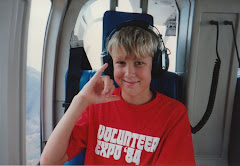Today I hovered for the first time using all flight controls without any assistance from my instructor. He tells me it lasted for 20 seconds or so before he had to act. I was shocked, because I was certain it was a minute or longer. I'll explain more about that towards the end of this post.
I
mentioned before that learning to fly a helicopter is a physical endeavor involving feeling the helicopter as an extension of yourself and then learning to balance it.
Think about the last time you learned to balance something, perhaps a basketball on your finger, or your body on a bicycle, in a handstand, or even on one foot. How did it happen?

I suspect that when you began, you were able to balance for only an extremely short period of time. Very quickly, things started to fall out of balance, you likely made a few last ditch moves of rapidly increasing magnitude, and then you lost it. The classic "whoa
whoa WHOA"...done.
With practice, you extended the time before the loss of balance. Your movements became more subtle, your corrections less excessive, and more time elapsed before the first "whoa." With enough practice, you extended the time long enough that the loss of balance never occurred; you could balance until you decided to stop.
During this process of practice and improvement, you didn't
think about how to improve. You didn't think "Oh it's going left, quick I need to reach more left!" The truth is, you don't have time to think about it. If you think about it, your reaction is too slow, and you lose the balance.
This is the amazing thing: Learning to balance happens completely outside the realm of conscious thought. It's as if your body learns it without your mind.
This is
exactly the process of learning to fly a helicopter, and holding a hover is the most acute example. You may recall that
my first hover lasted two seconds, after which I entered "whoa
whoa WHOA," sending the helicopter careening off at a deranged angle, and Lee had to take hold and bring it back.
That first time, I was only using my right hand, while Lee was managing the left hand and feet. Fast forward to today, when I was controlling all four flight controls (the cyclic, the collective, and right and left pedals) using my right hand, left hand, and right and left feet, respectively.
Today, as before, Lee had me focus on a palm tree several hundred yards in front of us and then just
feel the hover. This time, for the first time, I really did concentrate on the tree -- and nothing else. I stopped trying to control my limbs, I stopped
thinking about them or their motion.

The helicopter hovered. It was a bizarre sensation. It moved around a little, but as soon as it started to lean, I just willed it back. "Willed" is the best word I can use to describe it. It actually felt more telekinetic, like a medium might bend a spoon or move a bowl using mind energy alone. I just intensely silently expressed a desire for the helicopter to ease back into stillness...and it did.
I had no conscious interaction with my limbs. Although my hands and feet must have been making countless tiny corrections over fractions of seconds to maintain the hover, I have no memory of their motion. I can only remember the tree. (In a way, this was a little disappointing; I was so focused on the tree that I missed my own first hover.)
Actually, I do remember two specific movements, one by my right arm and one by my left foot. Right after each of these, I lost the hover and Lee had to act. So if I started
thinking about a hand or foot, things went to hell immediately.
Afterwards, I was sure my longest stretch of unassisted hover had lasted a minute or more. Lee said more like 20 seconds. I still can't understand that, because it felt so long.

I can come up with only one explanation. Have you ever been "in the zone" while playing a sport? It feels like time slows down, so you see and react much faster, often faster than your opponent. I think that's the same effect I felt today. When you are in a state of calm but intense concentration during a full-body physical endeavor, time gets stretched and feels longer than it is.
So maybe it was only 20 seconds. But it was pretty cool, anyway.
 This post has nothing to do with helicopters. I mentioned the other day that I went to a seahorse farm. First, let me give you a little background.
This post has nothing to do with helicopters. I mentioned the other day that I went to a seahorse farm. First, let me give you a little background. One of these companies is Ocean Rider, Inc., which operates the only seahorse farm in the world. They sell farm-raised, domesticated seahorses directly to home aquarium owners. Their business has deeply undercut the poaching of wild seahorses worldwide, giving this endangered creature a fighting chance for a future.
One of these companies is Ocean Rider, Inc., which operates the only seahorse farm in the world. They sell farm-raised, domesticated seahorses directly to home aquarium owners. Their business has deeply undercut the poaching of wild seahorses worldwide, giving this endangered creature a fighting chance for a future.



























